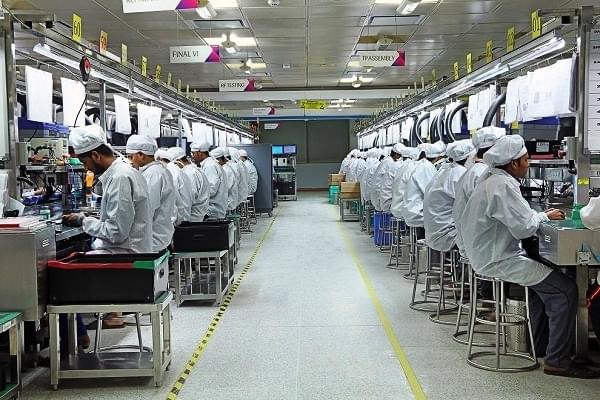Insta
National Electronics Policy Unveiled: Targets Rs 26 Lakh Crore Make In India Revenue, 100 Crore Mobile Manufactures By 2025
Swarajya Staff
Feb 21, 2019, 12:37 PM | Updated 12:37 PM IST
Save & read from anywhere!
Bookmark stories for easy access on any device or the Swarajya app.


The Union Cabinet on Tuesday (19 February) approved the National Electronics Policy 2019 which aims to achieve a turnover of Rs 2,600,000 crores ($400 billion) by 2025 via the domestic electronics manufacturing ecosystem.
It envisages setting up a cluster of the entire value chain and generate over 1 crore directly or indirect jobs to achieve a growth rate of 32 per cent.
The Policy aims to catapult India as a global hub for Electronics System Design and Manufacturing (ESDM) by incentivising and building capabilities in the country for developing core components, including chipsets, and creating an environment for the industry to compete globally.
Unveiling the new policy, Ravi Shankar Prasad, IT minister, said in a briefing "We aim to target Rs 26,00,000 crores ($400 billion) turnover by 2025 and are targeting a growth rate of 32 per cent from the current 26.7 per cent globally in five years. With the new policy, the electronic manufacturing sector alone will provide employment to about 1 crore people".
By creating an enabling ecosystem for globally competitive ESDM sector and promotion of domestic manufacturing and export in the entire value-chain of ESDM, the policy sets an ambitious production target of 100 crore mobile handsets by 2025, valued at approximately Rs 1,300,000 crore which includes 60 crore mobile handsets valued at Rs 700,000 crore for exports.
The Minister highlighted that the electronics production growth rate which was 5.5 per cent in 2015 has grown to 26.7 per cent 2017-18. The Minister added that in 2012-13, India's share in global electronics production was 1.31 per cent and has now steadily inched up to 3 per cent.
“When our government came to power, there were only two mobile factories. Now the number is 127 and if we add the components factories it will go up to 268. They employ 5 lakh people directly or indirectly.” the Minister added.
The policy aims to:
- Push the startup ecosystem in emerging technology areas, such as 5G, Internet of Things (IoT), artificial intelligence, machine learning, and their applications in areas like defence, agriculture, health, smart cities and automation.
- Providing incentives and support for manufacturing of core electronic components in India.
- Special focus on Fabless Chip Design Industry, Medical Electronic Devices Industry, Automotive Electronics Industry and Power Electronics for Mobility and Strategic Electronics Industry.
- Providing a special package of incentives for mega projects which are extremely high-tech and entail huge investments, such as semiconductor facilities display fabrication etc.
- Promote Industry-led R&D and innovation in all sub-sectors of electronics, including grass root level innovations and early stage Start-ups in emerging technology areas such as 5G, loT/ Sensors, Artificial Intelligence (Al), Machine Learning, Virtual Reality (VR), Drones, Robotics, Additive Manufacturing, Photonics, Nano-based devices.
- Providing incentives and support for significantly enhancing the availability of skilled manpower, including re-skilling.
- Create a Sovereign Patent Fund (SPF) to promote the development and acquisition of IPs in the ESDM sector.
- Promote trusted electronics value chain initiatives to improve national cybersecurity profile.





